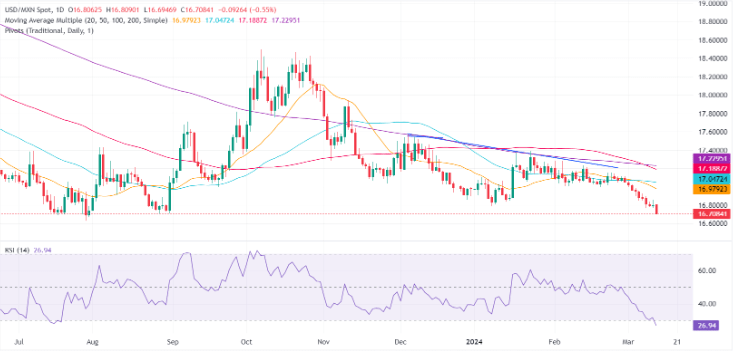- Mexican Peso strengthens to a YTD high amid light US economic data.
- Banxico Deputy Governor hints at possible rate cuts despite maintaining a restrictive policy outlook.
- Near-term momentum favors Peso, pushing USD/MXN to new lows despite dovish Banxico remarks.
The Mexican Peso surged to a new year-to-date high against the US Dollar on Wednesday, benefiting from a relatively quiet economic calendar in the United States. Despite robust US inflation data released on Tuesday and in line with expectations for Mexican Industrial Production, the USD/MXN pair traded at 16.74, marking a 0.31% decline.
During the day, Bank of Mexico (Banxico) Deputy Governor Omar Mejia made remarks, indicating a potential consideration for lowering the current interest rates set at 11.25%. However, Mejia emphasized the importance of maintaining a restrictive stance on future rate cuts. He highlighted the challenge of adjusting policy amidst evolving disinflation processes.
Despite Mejia’s dovish tone, the USD/MXN continued its downward trajectory, reaching new year-to-date lows as it approached the 16.70 level during the midweek session.
Daily digest market movers: Mexican Peso shrugs off warm US inflation data
- Mexico’s National Statistics Agency (INEGI) reported that Industrial Production in January met expectations, increasing by 0.4% MoM, rebounding from the previous month’s decline of -0.7%. On an annual basis, production surged by 2.9%, surpassing estimates and far outpacing December’s stagnant reading.
- In the United States, the latest Consumer Price Index (CPI) report validated the Federal Reserve’s decision to maintain interest rates unchanged, with inflation hovering above the 3% threshold. Fed Chair Jerome Powell and colleagues emphasized the need for more evidence before considering rate adjustments, affirming they are not in a hurry. Attention now shifts to upcoming data, including Retail Sales and the Producer Price Index (PPI), with mixed expectations. The next Fed meeting is slated for March 19-20.
- US business activity varied, with Factory Orders declining and the ADP Employment Change report indicating a cooling labor market despite steady private hiring. A downward revision in January’s Nonfarm Payrolls prompted reactions in the swaps market.
- According to a Reuters poll, investors anticipate the Fed to lead the way in rate cuts by June. Meanwhile, expectations for the Fed to slash rates by 75 basis points in 2024 prevail among 52 of 108 economists, with 26 forecasting a 100-basis-point cut.
- In the foreign exchange market, a Reuters poll projects the Mexican Peso to depreciate by 7% to 18.24 within 12 months. Analysts estimate a slowdown in February inflation, aligning with speculations of potential rate cuts at Banxico’s March 21 meeting.
- Banxico’s private analyst poll unveiled expectations for February inflation at 4.10%, core CPI at 4.06%, and economic growth at 2.40%, unchanged from January. Analysts anticipate Banxico to reduce rates to 9.50%, with the USD/MXN exchange rate projected at 18.31.
- During Banxico’s quarterly report, policymakers acknowledged inflation progress, advocating caution against premature rate cuts. Governor Victoria Rodriguez Ceja emphasized gradual adjustments, while Deputy Governors Galia Borja and Jonathan Heath urged prudence, warning against early rate cuts.
- Banxico revised its 2024 economic growth projections from 3.0% to 2.8% YoY, attributing the slowdown to higher interest rates at 11.25%. Amidst shifting sentiments, traders slightly reduced bets for a 25-basis-point rate cut in June, down to 64% from 72% previously, as indicated by the CME FedWatch Tool.
Technical analysis: Mexican Peso rally accelerates as USD/MXN edges toward 16.70
The downtrend in USD/MXN continues to gain momentum, with the Relative Strength Index (RSI) indicating oversold conditions. However, traders are closely monitoring the RSI for readings around 20.00 as the pair plunges towards last year’s low of 16.62. A breakthrough below this level could lead to a test of the October 2015 low at 16.32.
Nevertheless, to reverse this trend, the pair must reclaim the 17.00 level. This could potentially pave the way for a test of the 50-day Simple Moving Average (SMA) at 17.04, followed by the convergence of the 200-day SMA and the 100-day SMA at 17.23.
USD/MXN Price Action – Daily Chart

